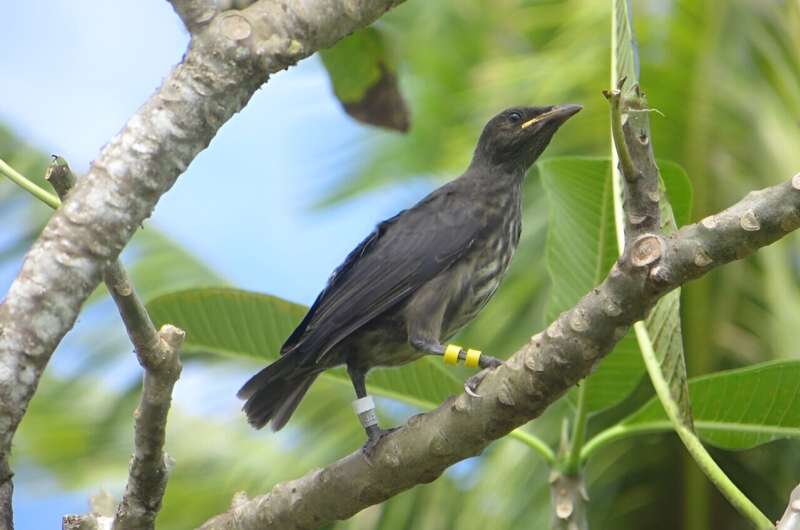This article has been reviewed according to Science X's editorial process and policies. Editors have highlighted the following attributes while ensuring the content's credibility:
fact-checked
peer-reviewed publication
trusted source
proofread
Research shows that brown treesnakes frequently kill prey too large to swallow

Brown treesnakes are not indigenous to Guam. The species arrived shortly after World War II, perhaps aboard shipping vessels. Since then, they have caused the local or total extinction of most native forest bird species.
Researchers including Haldre Rogers, a tropical forest community ecologist and conservation biologist in the College of Natural Resources and Environment have spent years conducting studies to support and inform bird conservation efforts.
Since 2007, Rogers has operated the Ecology of Bird Loss project in Guam to better understand how losing birds impacts the ecosystem and to form strategies to restore birds to the ecosystem. It has previously been suggested that while total eradication is optimal, removing the large, mature snakes—the ones big enough to eat birds—might be sufficient to allow some bird populations to recover.
Research, published on July 25 in Ecology and Evolution, shows that snakes are killing birds whether they can eat them or not, suggesting that they are routinely tackling prey that are too large for them to swallow.
"Around half of the birds that are getting killed by snakes are not actually eaten by them," said Martin Kastner, a doctoral student in the Department of Fish and Wildlife Conservation. Kastner has spent the last three years with a team in the Mariana Islands conducting the first study into the influence of both prey and predator sizes on brown treesnake predation success.
"Before this work, no one realized the extent to which snakes are unsuccessfully trying to predate birds," said Rogers. "I think we just assumed that most of the time they would be good at estimating how large a prey they would need, so it came as a big surprise to us that almost exactly half of the birds were not actually consumed."
The team attached radio transmitters to roughly 400 Såli fledglings, a medium-sized bird in the starling family that is locally endangered on Guam because of brown treesnake predation.
The fledglings that were unsuccessfully ingested by the brown treesnake were found dead on the ground with their heads and necks coated in saliva, whereas the fledglings that were successfully ingested were tracked to the bellies or feces of snakes.
The snake population at the site was also surveyed by the United States Geological Survey (USGS) Brown Treesnake Lab with measurements taken of all snakes found, allowing the team to compare the size of snakes that successfully ate birds to those on the landscape.
The study began in November 2019 and concluded in October of 2022:
- The team recorded 294 fledgling bird deaths out of 461 tracked.
- Brown treesnakes killed 58% of those, and cats killed 30%.
- Approximately half of the birds killed by the brown tree snakes were covered in saliva but not ingested.
Kastner was the lead writer of a paper on these findings titled, "Gape-limited invasive predator frequently kills avian prey that are too large to swallow." Along with Kastner and Rodgers, co-authors on the paper also included Scott M. Goetz, Kayla M. Baker, Shane R. Siers, Eben H. Paxton, and Melia G. Nafus. This paper is one part of Kastner's doctoral thesis.
"This chapter of Martin's thesis is really interesting. It helps managers figure out how much control is needed, and which age classes should be targeted," said Rogers. "These results have management implications because they show that smaller snakes can still effectively kill birds even if they can't actually swallow them, which means that there is a broader demographic range of snakes that need to be controlled."
Kastner's dissertation focuses on trying to understand the impact of snakes on Såli and to explore how snake control approaches correlate to fledgling survival and the overall population of the bird.
"In the right context, snakes are a big part of the ecosystem. They're wonderful in the right place, but in Guam, unfortunately, they're invasive, so that's important to keep in mind," said Kastner. "We need to get rid of them if we want hope of bringing back native birds and restoring the overall ecosystem."
Kastner has also helped establish Guam's first volunteer group dedicated to brown treesnake eradication, named "Friends of Islan Dåno."
Islan Dåno' is an islet located off Guam that has long been considered free from invasive brown treesnakes until recently.
An article by Kastner and the other co-founder, Olympia Terral, describing these efforts has been published in Berryman Institute's Human-Wildlife Interactions journal. Kastner and Rogers also have recently published a life history paper about Såli with many co-authors from the region.
In addition to the Department of Fish and Wildlife Conservation at Virginia Tech, the researchers have also worked closely with the USGS Pacific Island Ecosystems Research Center in Hawai'i National Park; the United States Department of Agriculture National Wildlife Research Center in Barrigada, Guam; and the Guam Department of Agriculture's Division of Aquatic and Wildlife Resources.
More information: Martin Kastner et al, Gape‐limited invasive predator frequently kills avian prey that are too large to swallow, Ecology and Evolution (2024). DOI: 10.1002/ece3.11598
Journal information: Ecology and Evolution
Provided by Virginia Tech





















